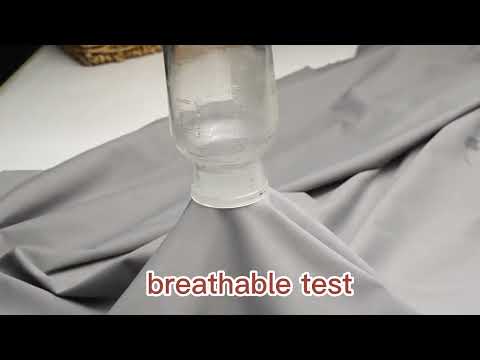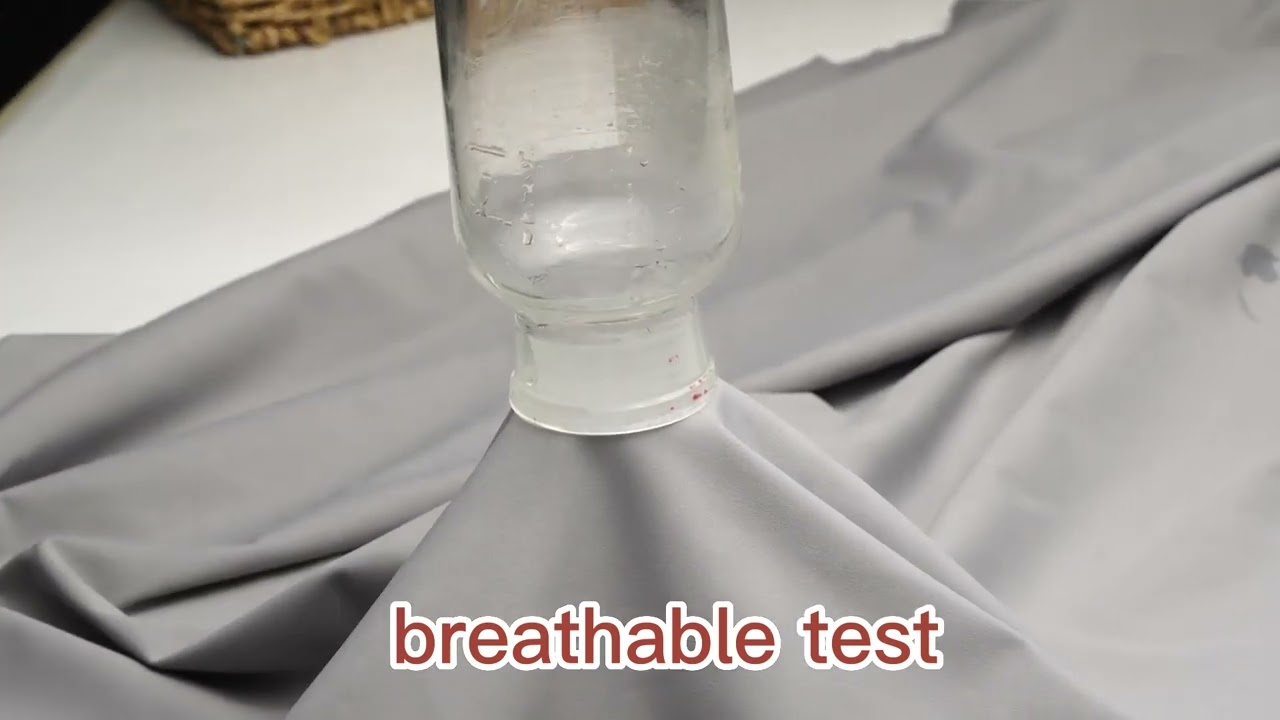Nylon and spandex fabric is a revolutionary blend that combines the best of both worlds in terms of comfort, flexibility, and durability. This fabric is perfect for those seeking a garment that effortlessly molds to their body’s contours while offering unparalleled support. The nylon component grants the fabric excellent strength and resilience, allowing it to withstand everyday wear and tear without losing its shape. Meanwhile, spandex adds a touch of elasticity that ensures a snug fit, regardless of body type or movement. Whether you’re engaging in high-intensity workouts or simply going about your daily activities, this fabric guarantees freedom of movement and unrestricted flexibility. The combination of these two materials creates a fabric that is not only soft and gentle against the skin but also highly breathable, wicking away moisture to keep you cool and dry throughout the day. With its nylon and spandex composition, this fabric is a game-changer for activewear, swimwear, and intimate apparel. Experience the ultimate blend of comfort and performance with this innovative fabric that will revolutionize your wardrobe.

The Versatility of Nylon and Spandex Fabric
When it comes to choosing the right fabric for clothing, there are several options available in the market. One fabric combination that has gained immense popularity over the years is nylon and spandex. This blend of fabrics offers unique benefits that make it a popular choice for various applications. In this article, we will delve into the characteristics, uses, and advantages of nylon and spandex fabric.
1. Understanding Nylon Fabric
Nylon is a synthetic thermoplastic material that was first introduced in the 1930s. It is a strong and durable fabric that has excellent resistance to wear and tear. Nylon is known for its lightweight nature and high elasticity, making it ideal for a wide range of applications.
Nylon fabric is commonly used in the textile industry for making garments, hosiery, swimwear, and even parachutes. It is also widely used in the production of bags, ropes, and tents due to its strength and resilience. The fabric is resistant to wrinkles and shrinkage, making it easy to care for.
2. The Unique Characteristics of Spandex
Spandex, also known as elastane or Lycra, is a synthetic fiber that was developed in the late 1950s. It is a highly elastic material that can stretch up to 600% of its original length without losing its shape. Spandex is known for its exceptional stretch and recovery properties, making it an essential component in many types of clothing.
Spandex fabric is commonly blended with other fibers, such as cotton or nylon, to enhance their stretch and flexibility. This fabric is widely used in the production of sportswear, swimwear, and activewear due to its ability to provide a snug fit and freedom of movement. It is also commonly found in undergarments, socks, and medical compression garments.
3. The Advantages of Nylon and Spandex Blend
Nylon and spandex fabric offers a unique combination of characteristics that make it highly desirable for various applications.
Firstly, the blend of nylon and spandex provides excellent stretch and recovery properties, allowing the fabric to retain its shape even after repeated stretching. This attribute makes it ideal for form-fitting garments and activewear that require flexibility and comfort.
Secondly, nylon and spandex fabric is highly durable and resistant to tearing, making it perfect for garments that undergo frequent use and washing. This fabric can withstand rigorous activities and maintain its integrity over time.
Additionally, the fabric is lightweight and breathable, allowing for proper air circulation and moisture management. This feature makes it suitable for sportswear and swimwear, as it helps to keep the body cool and dry during physical activities.
Furthermore, the nylon component of the fabric provides excellent colorfastness, ensuring that the garment retains its vibrant colors even after multiple washes. This attribute is particularly important for swimwear and activewear, as they are exposed to chlorine, sweat, and sunlight.
4. Applications of Nylon and Spandex Fabric
The versatility of nylon and spandex fabric makes it suitable for a wide range of applications.
One of the most common uses of this fabric blend is in the production of swimwear. The stretch and quick-drying properties of nylon and spandex make it an ideal choice for swimsuits, allowing for a comfortable and flattering fit.
The fabric is also widely used in the manufacturing of sportswear and activewear. Its stretch and moisture-wicking properties make it perfect for leggings, sports bras, and athletic tops that require flexibility and breathability.
Additionally, nylon and spandex fabric is often utilized in the production of undergarments and shapewear. The fabric’s stretch and compression properties help to smooth and contour the body, providing a slimming effect.
5. Care and Maintenance of Nylon and Spandex Fabric
To ensure the longevity of nylon and spandex fabric, it is important to follow proper care and maintenance guidelines.
It is recommended to wash garments made from this fabric blend in cold water with a gentle detergent. Avoid using bleach or fabric softeners, as they can damage the fibers and reduce the fabric’s elasticity.
When drying, it is best to air-dry the garments or use a low-heat setting on the dryer. Excessive heat can cause the fabric to lose its elasticity and shape.
Additionally, it is advisable to avoid ironing nylon and spandex fabric, as the high heat can melt or deform the fibers. If necessary, use a low-temperature setting or place a cloth between the fabric and the iron.
In conclusion, nylon and spandex fabric is a versatile and durable option for various clothing applications. Its unique combination of stretch, durability, and breathability makes it highly desirable for swimwear, sportswear, and undergarments. By following proper care and maintenance guidelines, you can ensure the longevity of garments made from this fabric blend.
“Nylon Spandex Fabric: Unleashing Breathability and Wicking Prowess!”
Video Source : Wingtex Fabric Solution
Nylon and Spandex Fabric
- Nylon is a synthetic fiber known for its strength and durability.
- Spandex, also known as Lycra or elastane, is a synthetic fiber known for its elasticity.
- Nylon fabric is lightweight, smooth, and resistant to abrasion.
- Spandex fabric is highly stretchable and can be stretched up to 600% of its original length.
- Nylon fabric is commonly used in the production of various garments, such as jackets, swimwear, and activewear.
- Spandex fabric is widely used in the manufacturing of sportswear, underwear, and form-fitting clothing.
- Nylon fabric is moisture-wicking, quick-drying, and breathable.
- Spandex fabric provides excellent shape retention and is resistant to wrinkling.
- Nylon and spandex are often blended together to create a fabric that combines the benefits of both fibers.
- Both nylon and spandex fabrics are easy to care for and can be machine washed.
Fabric Comparison: Nylon vs. Spandex
| Property | Nylon | Spandex |
|---|---|---|
| Composition | Nylon is a synthetic polymer made from petroleum-based chemicals. | Spandex, also known as elastane, is a synthetic fiber made from polyurethane. |
| Elasticity | Nylon offers moderate stretchability, providing excellent flexibility and shape retention. | Spandex, on the other hand, is renowned for its exceptional elasticity, allowing it to stretch up to 500% of its original length. |
| Strength | Nylon boasts remarkable strength, making it highly durable and resistant to abrasions and tears. | Spandex, although not as strong as nylon, offers superior strength when it comes to stretching and recovery. |
| Moisture Management | Nylon exhibits good moisture wicking properties, effectively keeping the body dry and comfortable. | Spandex, while not inherently moisture-wicking, is often blended with other fabrics to improve their moisture management capabilities. |
| Breathability | Nylon is breathable to a certain extent, allowing air circulation and preventing overheating. | Spandex, due to its composition, is less breathable than nylon. It is often blended with other fabrics to enhance breathability. |
| Applications | Nylon is commonly used in various applications such as activewear, swimwear, hosiery, and outdoor gear. | Spandex is predominantly utilized in form-fitting garments, athletic wear, and stretchable fabrics. |
In summary, both nylon and spandex offer unique properties that make them ideal for different applications. Nylon excels in durability, moderate stretchability, and moisture management, while spandex shines in its exceptional elasticity and recovery capabilities. Understanding the characteristics of these fabrics allows designers and consumers to make informed decisions based on their specific needs and preferences.

